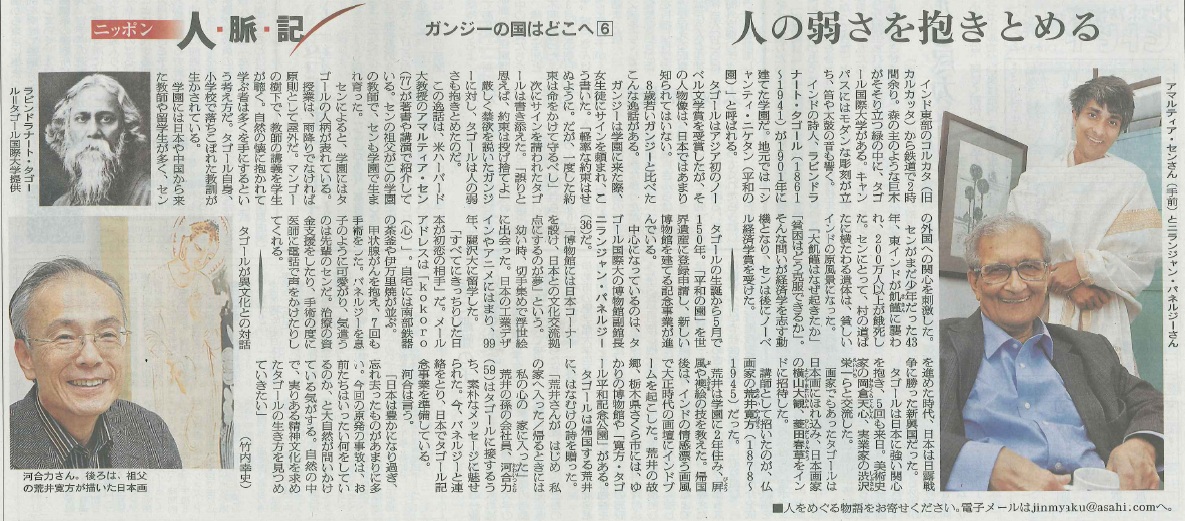 |
||||||||||||
|
|
Where is the Country of Gandhi going? < 6 > written by Takeuchi April 4, 2011 Asahi Shinbun  Holding Human Weakness Holding Human Weakness Over two hours by train from Kolkata (former Calcutta) in eastern India, the Tagore International University is located in a rich green land where towering trees rise like Master of the Woods . Modern sculptures are placed throughout the campus and the sounds of flutes and drums fill the air. Indian poet Sir Rabindranath Tagore (1861-1941) built this educational institution in 1901. It is called locally as ‘Shanti Niketan,’ which means Garden of Peace. Tagore was the first to be awarded the Nobel Prize for Literature in Asia; however, not much is known in Japan about his personality or character. Tagore has been compared to Mahatma Gandhi who was eight years his junior. When Gandhi visited the campus, a female student asked for his autograph and he wrote: “Do not make thoughtless promises. However, once made, promises should be kept even at the peril of your life’ Tagore, who was also asked to give her an autograph, added: ‘If you think that the promise made was wrong, throw it away.’ Compared to Gandhi who strictly preached asceticism, Tagore accepted the human weakness. Amartya Sen (77), a professor at Harvard University in the United States uses this anecdote in his introductions during lectures and in publications. Sen’s grandfather was a teacher at the school and Sen himself was born and raised there. According to Sen, this educational institution reflects the personality of its founder, Tagore. As a rule, classes are held outdoors unless it rains. Students listen to the lectures by the teachers under mango trees. The practice is based on the belief that those who study in the environment surrounded by nature will learn and obtain many . Tagore understood this lesson very well since he was a child who had been left behind in elementary school. The presence of many teachers and students from Japan and China at the school stimulated Sen’s interests to learn about the world beyond India’s borders. In 1943, when Sen was only a young boy, more than two million people died from starvation caused by the famine in Eastern India. For Sen, the images of dead bodies lying along the village roads became archetypal of poor India. “Why do great famines happen?” and “How can a society overcome poverty?” are questions that motivated Sen to pursue to study economics. These studies later earned him a Nobel Prize in Economic Sciences. May marks the 150th anniversary of Tagore’s birth. [Tagore University] has engaged in the commemorative activities, by building a new museum that will embody the spirit of the ‘Garden of Peace’ or Shanti Niketan, wit hopes that one day, it will be listed as a World Heritage site. The person leading the efforts is Nilanjan Banerjee (36), the vice director of the Rabindra-Bhavana Museum. He says “It is my dream to set up a Japan section and to promote it as an outlet of cultural exchanges with Japan”. When Banerjee was small, he was introduced to the world of Ukiyoe through stamp collecting. He was completely sold on Japanese industrial designs and animation and went to study at Reitaku University. He says, “My first love was Japan--it was precise in everything.” His email address contains ‘kokoro’ which means heart in Japanese. At home, he has collections of Nanbu iron tea kettles and Imari ware. He has cancer of the thyroid and has endured seven surgeries. Sen, who is a senior to him, treats Banerjee as if he were his own son. Sen has helped by providing financial assistance for medical treatments and he called doctors every time Banerjee went through surgery. During the period when Tagore promoted communication among the different cultures, Japan was a newly emerging nation that had won the Russo-Japanese War.Since Tagore was very interested in Japan, he visited the country five times. Among those he interacted were Tenshin Okakura, an art historian and Eiichi Shibusawa, a businessman. As a painter himself, Tagore was charmed by Japanese drawings and he invited Japanese painters such as Taikan Yokoyama and Shunsou Hishida to India. Tagore also invited Buddhist painter Kanpo Arai (1878 ? 1945) to India as a lecturer. Arai lived at the campus for two years and taught techniques of painting on folding screens and fusuma or sliding screens. After returning to Japan, Arai’s style, which was infused with Indian influences, enjoyed something of an Indian boom to the world of art in Taisho period. Arai’s hometown, Sakura-city of Ibaraki Prefecture has a museum in connection with him and “Kanpo & Tagore Peace Park”. Upon Arai’s returning to Japan, Tagore sent him a poem of farewell. ‘Arai-san, at first, came into my house / when he returned, he came into the house, in my heart’ Tsutomu Kawai (59), a grandson of Arai and an office worker, was attracted to the simple messages of Tagore while he came across his work. Now he is in touch with Banerjee and is preparing commemorative activities featuring Tagore in Japan. Kawai says, “As Japan became rich, it has forgotten too many things. I feel that the nuclear accident this time is a question asked by Mighty Nature, ‘What is it that you are doing?’ I would like to gaze into the life that Tagore lived in nature, in pursuit of fruitful spiritual civilization”. (Article written by Takeuchi) Photo on the right: Nilanjan Banerjee and Amartya Sen Photo on the left top: Sir Rabindranath Tagore (source: Visva-Bharati University) Photo on the left bottom: Tsutomu Kawai with his grandfather, Kanpo Arai’s painting in the back. This article appeared in the April 4, 2011 Asahi Shinbun Newspaper. The article was translated into English by Ayumi Somers. |
|||||||||||
|
|
〒105-0001 東京都港区虎ノ門1-1-18 東京虎ノ門ビル1階 MBE330 タゴール生誕150年記念会私書箱 FAX:045-788-2816 E-mail:tagore150japan@yahoo.co.jp |